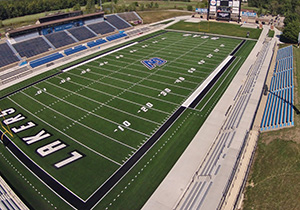A Michigan landscape company uses drones to capture aerial images of large-scale projects.

It was a conundrum that long plagued Tom VerHage, owner of Grand Rapids, Mich.-based Katerberg VerHage Landscaping: How can we get complete, quality photographs of our large-scale projects? The helicopters the company used in the past were cost prohibitive, so VerHage was on the lookout for a cheaper, convenient way to photograph his company’s largest projects like university campuses, parks, stadiums and some residences. About three years ago, VerHage finally found an efficient and affordable way to get the shots he wanted with a new-age device called an unmanned aerial system (UAS) — aka a drone.
“We always felt we couldn’t do our larger projects justice with just on-the-ground shots,” VerHage says. “We used a helicopter in the past and it was very expensive. It didn’t make sense. The drones are a great way to do it. It works wonderfully.”
Katerberg VerHage works with a company called Hovercams, also based in Grand Rapids, to take low-altitude aerial images of the $8.4-million company’s largest projects using a remote-controlled UAS. With this device, Hovercams is able to provide photos of projects from up to 200 feet in the air. The technology also allows the drone to zoom in on specific details from above, such as a water feature, pool or patio.

Most recently, Katerberg VerHage built rock walls on three sides of the artificial turf football field at Grand Valley State University (GVSU) in Allendale, Mich., as well as the stadium on the school’s practice fields. The drone captured the finished project with high-resolution images of the entire field.
“The photos give us a great view from 100 to 200 feet in the air or right down into specific target areas,” VerHage says. “The higher you go, you get a view of the whole project.”
VerHage says his company uses the aerial shots mostly as a marketing tool for its 90-percent commercial clientele. But because the company does not pass along a fee to clients for the photos, he says it’s selective over which projects are worthy of the Hovercams treatment. Costs ranges from $150 to $200 for 10 to 15 photos per session, VerHage says.
“The money goes a long way in getting these pictures taken,” he says. “It gives you a good bang for your dollar.”
VerHage adds clients seem to enjoy the imagery, too, and many of them end up framing and displaying the photos throughout their buildings.
“Customers are very impressed with the service,” VerHage says. “It works really well for them and they like to keep the photos as part of their history.”
Another benefit to the drone photography service, VerHage says, is capturing the images is simple. A Katerberg VerHage project manager meets a representative from the photography firm at the project site. After explaining the types of shots and details they are looking for, the rep—who VerHage says has an “architect’s eye”—operates the drone while taking the photos. The whole process takes less than an hour. Sometimes a project requires two sessions if Katerberg VerHage wants before-and-after shots.
Photos: Katerberg VerHage

